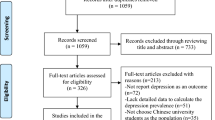Abstract
The Zung Self-Rating Depression Scale (SDS) is generally used to screen for the presence of depression. The purpose of this study was to investigate scores on the SDS, Japanese version, in undergraduates at Tsurumi University School of Dental Medicine in Yokohama, Japan. A total of 2,197 dental students completed the SDS from 2006 through 2008. The investigation took place each year over a 3-week period from June to July. When investigating, the Institutional Review Board at Tsurumi University approved the study. Students could voluntarily agree or decline to participate in the study, and all responses were provided anonymously. SDS scores by sex, class year, and change over time were analyzed. The mean SDS score ranged from 43.7 ± 8.5 to 44.8 ± 9.0 between 2006 and 2008. Women were significantly more depressed than men in 2007 and 2008. The SDS scores of the same students were high continuously for 2 years. “Diurnal variation,” “personal devaluation,” and “confusion” had the highest scores of the 20 individual items of the SDS. Of the participating students, 31.4–37.2% were classified as being moderately to severely depressed. Logistic regression analysis was used to compute the odds ratio for SDS scores of ≤47 versus ≥48. The item “suicidal rumination” had the highest chance of being associated with depressive symptoms in all 3 years. Although this research was limited to a single department of dentistry, it appears that dental students experience various levels of depression. Providing mental healthcare options to these students may be helpful.
Similar content being viewed by others
References
Zung W, Durham N. A self-rating depression scale. Arch Gen Psychiatry. 1965;12:63–70.
Radloff LS. The CES-D scale: a self-report depression scale for research in the general population. Appl Psychol Meas. 1977;1:358–401.
Inam SN, Saqib A, Alam E. Prevalence of anxiety and depression among medical students of private university. J Pak Med Assoc. 2003;53(2):44–7.
Chandavarkar U, Azzam A, Mathews CA. Anxiety symptoms and perceived performance in medical students. Depress Anxiety. 2007;24(2):103–11.
Rab F, Mamdou R, Nasir S. Rates of depression and anxiety among female medical students in Pakistan. East Mediterr Health J. 2008;14(1):126–33.
Aniebue PN, Onyema GO. Prevalence of depressive symptoms among Nigerian medical undergraduates. Trop Doct. 2008;38(3):157–8.
Fukuda K, Kobayashi S. A study on a self-rating depression scale. Seishin shinkei gaku zasshi. 1973;75:673–9. (in Japanese).
Barrett J, Hurst MW, DiScala C, Rose RM. Prevalence of depression over a 12-month period in a nonpatient population. Arch Gen Psychiatry. 1978;35(6):741–4.
Sakamoto S, Kijima N, Tomoda A, Kambara M. Factors structures of the Zung self-rating depression scale (SDS) for undergraduates. J Clin Psychol. 1998;54:477–87.
Kawada T, Suzuki S. Factor structure of Zung self-rating depression scale for workers. Jpn J Psychiatry Neurol. 1993;47:23–7.
Zung WWK. Depression in the normal adult population. Psychosom. 1971;12:164–7.
Knight RG, Waal-Manning HJ, Soears GF. Some norms and reliability data for the state-trait anxiety inventory and the Zung self-rating depression scale. Br J Clin Psychol. 1983;22:245–9.
Hymes RW, Akiyama MM. Depression and self-enhancement among Japanese and American students. J Soc Psychol. 1991;131(3):321–34.
Chida F, Okayama A, Nishi N, Sakai A. Factor analysis of Zung Scale scores in a Japanese general population. Psychiatry Clin Neurosci. 2004;58(4):420–6.
Liu XC, Ma DD, Kurita H, Tang MQ. Self-reported depressive symptoms among Chinese adolescents. Soc Psychiatry Psychiatr Epidemiol. 1999;34(1):44–7.
Weissman MM, Klerman GL. Sex differences and the epidemiology of depression. Arch Gen Psychiatr. 1977;34:98–111.
Hirschfeld RMA, Cross CK. Epidemiology of affective disorders. Arch Gen Psychiatr. 1982;39:35–46.
De Jonghe JFM, Baneke JJ. The Zung self-rating depression scale: a replication study on reliability, validity and prediction. Psychol Rep. 1989;64:833–4.
Yamazaki S, Fukuhara S, Green J. Usefulness of five-item and three-item Mental Health Inventories to screen for depressive symptoms in the general population of Japan. Health Qual Life Outcomes. 2005;3:48.
Chan DW. Depressive symptoms and depressed mood among Chinese medical students in Hong Kong. Compr Psychiatry. 1991;32(2):170–80.
Kitamura T, Hirano H, Chen Z, Hirata M. Factor structure of the Zung Self-rating Depression Scale in first-year university students in Japan. Psychiatry Res. 2004;128(3):281–7.
Innamorati M, Pompili M, Ferrari V, Girardi P, Tatarelli R, Tamburello A, Lester D, Università Europea of Rome. Cannabis use and the risk behavior syndrome in Italian university students: are they related to suicide risk? Psychol Rep. 2008;102(2):577–94.
Author information
Authors and Affiliations
Corresponding author
Rights and permissions
About this article
Cite this article
Takayama, Y., Miura, E., Miura, K. et al. Condition of depressive symptoms among Japanese dental students. Odontology 99, 179–187 (2011). https://doi.org/10.1007/s10266-011-0005-6
Received:
Accepted:
Published:
Issue Date:
DOI: https://doi.org/10.1007/s10266-011-0005-6




